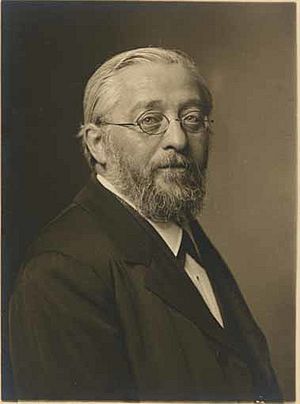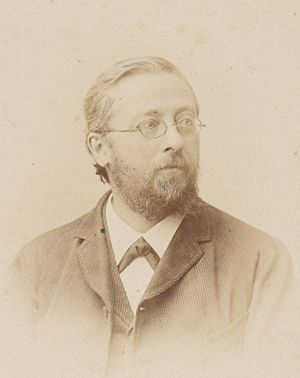Paul Heinrich von Groth facts for kids
Paul Heinrich Ritter von Groth (born June 23, 1843 – died December 2, 1927) was a German scientist who studied minerals. He is best known for creating a new way to sort minerals. He grouped them based on what they were made of (their chemical composition) and how their tiny parts were arranged (their crystal structure).
Contents
Paul von Groth's Early Life and Career
Paul Heinrich von Groth was born in Magdeburg, Germany. He studied in cities like Freiberg, Dresden, and Berlin. In 1868, he earned his doctorate degree, which is a very high academic qualification.
After teaching at the Freiberg mining school and the University of Berlin, he became a professor. In 1872, he started teaching about minerals at the University of Strasbourg. Later, in 1883, he moved to Munich. There, he became a professor of mineralogy and also helped look after the mineral collection at the Deutsches Museum.
Paul von Groth passed away in Munich.
Discoveries and Contributions to Science
Paul von Groth spent a lot of time studying crystals, minerals, and rocks. He wrote important books that helped people understand these subjects better.
Organizing Minerals and Crystals
One of his key books was Tabellarische Übersicht der einfachen Mineralien, published between 1874 and 1898. He also wrote Physikalische Krystallographie (Physical Crystallography), which was very important. This book helped scientists use methods from crystallography to study organic chemistry, which is the study of carbon-based compounds.
In 1877, von Groth started a science magazine called Zeitschrift für Krystallographie und Mineralogie. He was the editor of this magazine until 1920, helping to share new discoveries about crystals and minerals. In 1883, he put together a huge five-volume collection called Chemische Kristallographie. This work included detailed information about the shapes and properties of thousands of different substances.
Understanding Space Groups
By von Groth's time, scientists already knew about Dalton's atomic theory, which says that everything is made of tiny particles called atoms. In 1888, von Groth was the first to suggest that these atoms might sit in specific, repeating patterns within a crystal. He thought of them as spheres placed at regular points in a "space lattice." This idea helped make the abstract concept of how atoms are arranged in space more real.
Other scientists, like Leonhard Sohncke, Schönflies, Fedorov, and Barlow, also worked on understanding these patterns. They mathematically described all 230 possible ways that atoms can be arranged in a crystal, known as "space groups." Later, in 1922, Ralph Walter Graystone Wyckoff wrote a book that made it easier for scientists to use this information.



